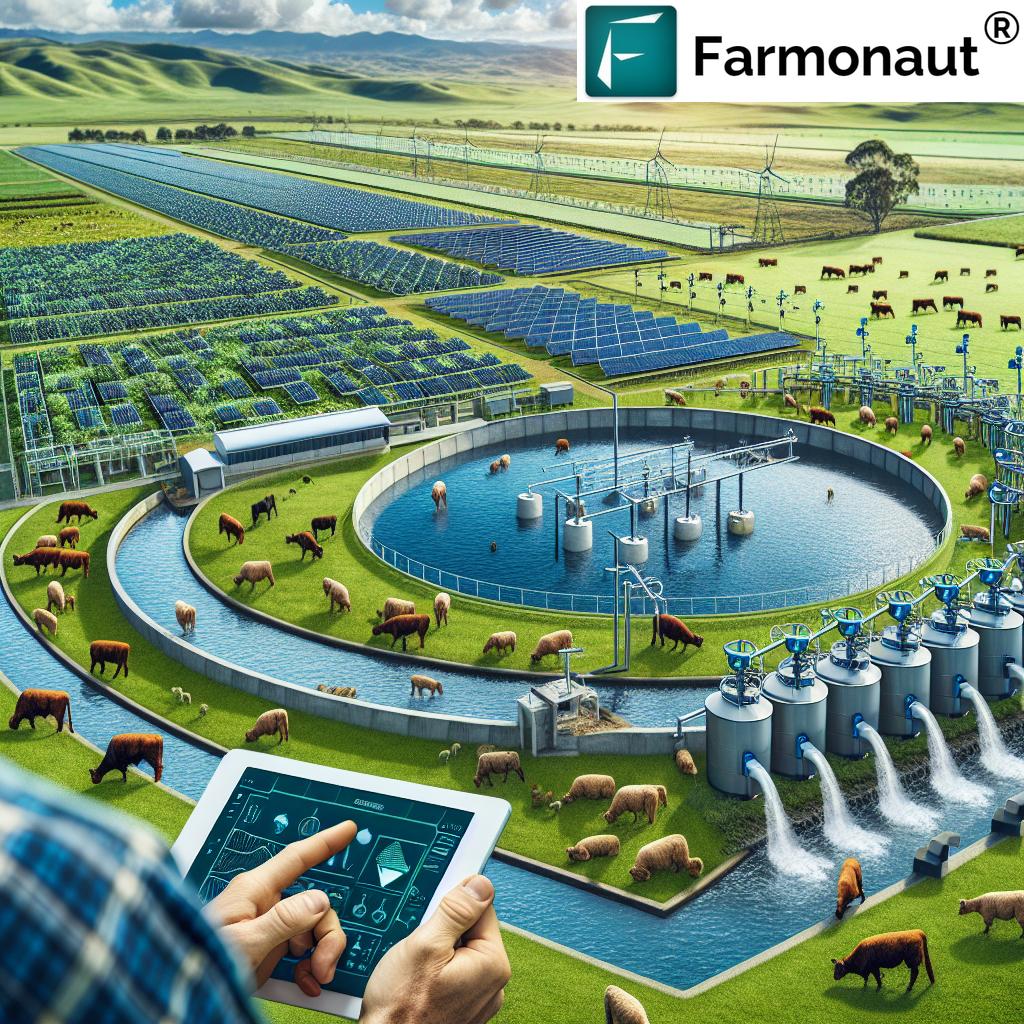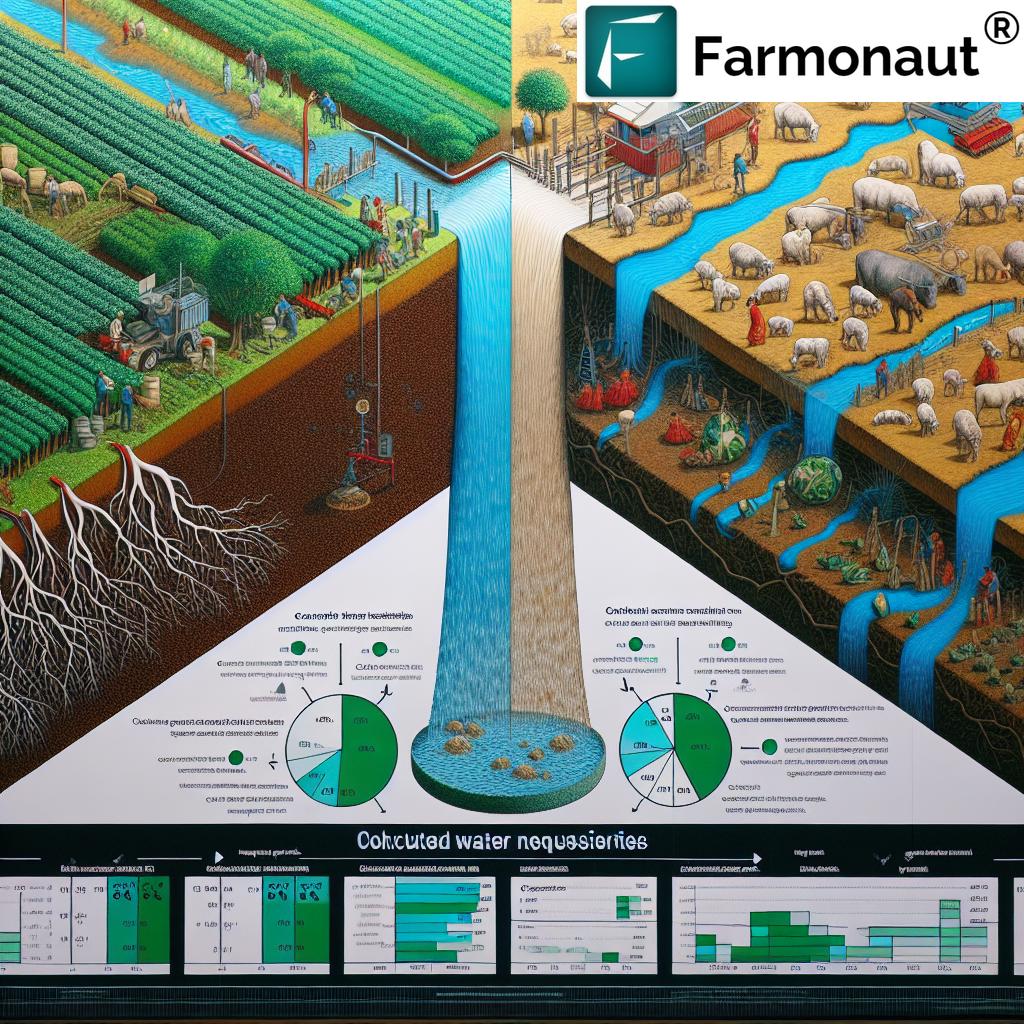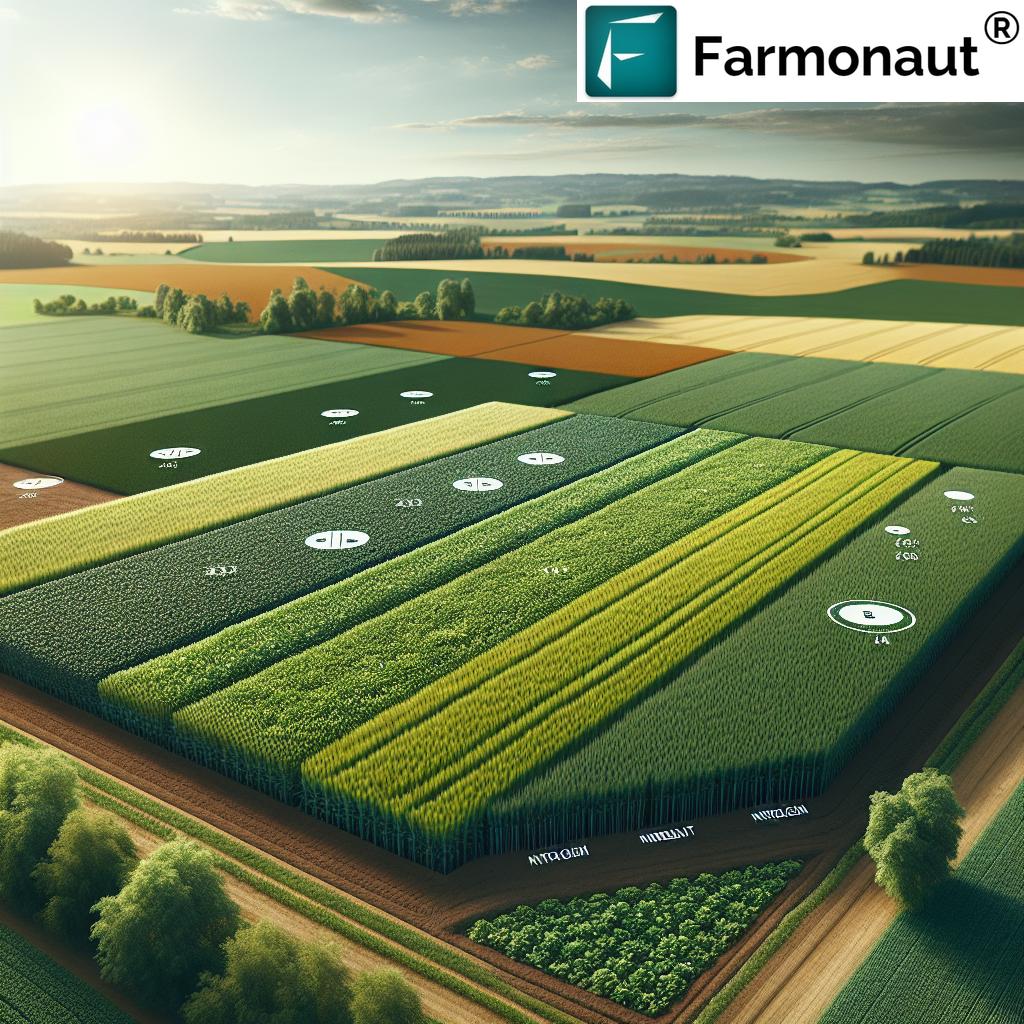Mastering Farm Water Management: A Comprehensive Guide to Boost Livestock Productivity and Drought Resilience

“Proper water management can increase livestock productivity by up to 25% and reduce drought vulnerability by 40%.”
Welcome to our comprehensive guide on mastering farm water management! In this blog post, we’ll explore essential strategies to boost livestock productivity and enhance drought resilience on your farm. As we navigate through the intricate world of agricultural water planning, we’ll provide you with practical insights, expert advice, and cutting-edge solutions to optimize your farm’s water use.
At Farmonaut, we understand the critical role that effective water management plays in sustainable agriculture. Our precision farming technology is designed to support farmers in implementing robust water management strategies, ultimately leading to improved agricultural resource management and increased farm profitability.
Understanding Farm Water Management
Farm water management is a cornerstone of successful agricultural operations, especially when it comes to livestock farming. It encompasses a wide range of practices and strategies aimed at optimizing water use, ensuring reliable supply, and mitigating the impacts of droughts and other water-related challenges.
Effective water management on farms involves:
- Assessing water requirements for livestock and crops
- Evaluating and developing water sources
- Implementing efficient storage and distribution systems
- Monitoring water quality and quantity
- Planning for drought and other water scarcity scenarios
By mastering these aspects, farmers can significantly improve their farm’s resilience, productivity, and sustainability.
Assessing Livestock Water Requirements
Understanding the water needs of your livestock is crucial for effective farm water management. Different animals have varying water requirements based on factors such as species, age, weight, production stage, and environmental conditions.
| Animal Type | Average Daily Water Requirement (Gallons) | Factors Affecting Consumption | Water Quality Considerations |
|---|---|---|---|
| Dairy Cow | 30-50 | Lactation stage, temperature, feed type | Low salinity, neutral pH |
| Beef Cattle | 10-20 | Weight, temperature, feed moisture | Moderate mineral content |
| Sheep | 1-4 | Pregnancy, lactation, wool production | Low nitrate levels |
| Goats | 1-3 | Milk production, environmental heat | Clean, fresh water |
It’s essential to account for these requirements when planning your farm’s water system. Overestimating or underestimating water needs can lead to inefficiencies or shortages that may impact animal health and productivity.
Evaluating Water Sources and Reliability
A crucial step in farm water planning is assessing the available water sources and their reliability. Common water sources for farms include:
- Surface water (rivers, streams, lakes)
- Groundwater (wells, springs)
- Rainwater harvesting
- Municipal water supply
Each source has its advantages and challenges. For instance, surface water may be more susceptible to contamination and seasonal fluctuations, while groundwater often provides a more stable supply but may require energy-intensive pumping systems.
To evaluate the reliability of your water sources, consider:
- Historical data on water availability
- Seasonal variations in supply
- Potential impacts of climate change
- Legal and regulatory considerations
By thoroughly assessing your water sources, you can develop a more robust and resilient water management plan for your farm.
Designing Efficient Water Storage Solutions
Proper water storage is crucial for ensuring a consistent supply, especially during dry periods or when primary water sources are unreliable. Effective storage solutions can help buffer against shortages and improve overall water security on your farm.
Key considerations for designing water storage systems include:
- Storage capacity based on water requirements and supply variability
- Type of storage (e.g., dams, tanks, reservoirs)
- Location and accessibility
- Construction materials and durability
- Maintenance requirements
When planning your storage system, it’s important to factor in potential losses due to evaporation, seepage, and other factors. Implementing measures such as covers for tanks or selecting appropriate dam sites can help minimize these losses.
Infrastructure Planning for Efficient Water Distribution
A well-designed water distribution system is essential for ensuring that water reaches all areas of your farm efficiently. This involves careful planning of pipelines, troughs, and other infrastructure components.
Key elements of effective water distribution infrastructure include:
- Properly sized pipes to maintain adequate water pressure
- Strategically placed troughs to minimize travel distance for livestock
- Robust materials that can withstand environmental conditions and animal interactions
- Monitoring systems to detect leaks or other issues
When planning your distribution system, consider the topography of your land and explore options like gravity-fed systems where possible. These can be highly cost-effective and energy-efficient compared to pumped systems.
“Efficient gravity-fed water systems can save farmers up to 70% on energy costs compared to pumped systems.”
Implementing Water Conservation Techniques
Water conservation is a critical aspect of sustainable farm management. By implementing effective conservation techniques, you can reduce water waste, lower costs, and improve your farm’s resilience to drought conditions.
Some key water conservation strategies include:
- Repairing leaks promptly
- Using drought-resistant pasture species
- Implementing rotational grazing to allow pasture recovery
- Installing water-efficient irrigation systems for crops
- Collecting and reusing rainwater
These techniques not only conserve water but can also contribute to improved soil health and pasture productivity.
Leveraging Technology for Precision Water Management
Modern technology offers powerful tools for optimizing farm water management. Precision farming solutions, like those offered by Farmonaut, can provide valuable insights and assist in implementing effective water management strategies.
Some ways technology can enhance water management include:
- Satellite-based crop health monitoring to optimize irrigation
- AI-powered advisory systems for water use planning
- Remote sensing for early detection of water stress in crops and pastures
- Automated monitoring and control of water distribution systems
By leveraging these technologies, farmers can make more informed decisions about water use, leading to improved efficiency and productivity.

Preparing for Droughts and Water Shortages
Drought preparedness is an essential aspect of farm water management, especially in regions prone to water scarcity. A well-thought-out drought management plan can help minimize the impact of water shortages on your livestock and overall farm operations.
Key elements of a drought preparedness plan include:
- Developing alternative water sources
- Implementing water-efficient practices
- Creating feed reserves
- Establishing trigger points for destocking
- Planning for water carting if necessary
Regular review and updating of your drought management plan is crucial to ensure its effectiveness in the face of changing climate conditions.
Monitoring and Maintaining Water Quality
Water quality is as important as quantity when it comes to livestock health and productivity. Poor water quality can lead to reduced water intake, health issues, and decreased production.
Key aspects of water quality monitoring include:
- Regular testing for contaminants
- Monitoring salinity levels
- Checking for algal blooms in surface water sources
- Ensuring proper fencing to prevent livestock from contaminating water sources
Implementing water treatment systems may be necessary depending on the quality of your water sources. This could include filtration, aeration, or chemical treatment methods.
Integrating Water Management with Overall Farm Planning
Effective water management should be integrated into your broader farm management strategy. This holistic approach ensures that water-related decisions align with other aspects of your farm operations, such as grazing management, crop rotation, and livestock breeding programs.
Consider the following when integrating water management into your farm plan:
- Aligning water infrastructure development with long-term farm goals
- Incorporating water considerations into pasture and crop management decisions
- Factoring water availability into stocking rate decisions
- Planning for future expansion or diversification of farm enterprises
By taking a comprehensive approach to farm planning, you can ensure that your water management strategies support and enhance other aspects of your agricultural operations.
Sustainable Practices for Long-term Water Security
Implementing sustainable practices is crucial for ensuring long-term water security on your farm. These practices not only conserve water but also contribute to overall farm resilience and environmental stewardship.
Some key sustainable water management practices include:
- Protecting and restoring natural water catchments
- Implementing soil conservation techniques to improve water retention
- Using cover crops to reduce evaporation and improve soil structure
- Adopting agroforestry practices to enhance water cycle management
- Exploring innovative water-saving technologies
By embracing these sustainable practices, you can improve your farm’s water security while also contributing to broader environmental conservation efforts.
Leveraging Farmonaut’s Technology for Improved Water Management
At Farmonaut, we offer cutting-edge precision farming technology that can significantly enhance your farm’s water management strategies. Our satellite-based crop monitoring and AI-powered advisory systems provide valuable insights to optimize water use and improve overall farm efficiency.
Key features of Farmonaut’s technology for water management include:
- Real-time crop health monitoring to guide irrigation decisions
- Soil moisture analysis for optimal water application
- Weather forecasting to support proactive water management
- AI-driven recommendations for water-efficient farming practices
By integrating Farmonaut’s technology into your farm operations, you can make more informed decisions about water use, leading to improved productivity and sustainability.
Explore Farmonaut’s solutions:
For developers interested in integrating our technology into their own solutions, check out our API and API Developer Docs.
Cost-Benefit Analysis of Water Management Investments
Investing in improved water management systems and practices can require significant upfront costs. However, these investments often lead to substantial long-term benefits in terms of increased productivity, reduced operational costs, and improved farm resilience.
When conducting a cost-benefit analysis, consider the following factors:
- Initial investment costs for infrastructure and technology
- Potential water savings and associated cost reductions
- Improvements in livestock health and productivity
- Reduced vulnerability to droughts and water shortages
- Potential increase in property value
Remember to factor in both short-term and long-term benefits when evaluating the return on investment for water management improvements.
Legal and Regulatory Considerations
Water use in agriculture is often subject to various legal and regulatory requirements. It’s crucial to be aware of and comply with these regulations to ensure sustainable and lawful water management practices on your farm.
Key legal and regulatory considerations may include:
- Water rights and allocation limits
- Environmental protection requirements
- Reporting and monitoring obligations
- Restrictions on water use during drought periods
Stay informed about the regulations in your area and consider consulting with legal experts or agricultural advisors to ensure compliance with all relevant laws and regulations.
Collaborative Approaches to Water Management
Water management often extends beyond individual farm boundaries. Collaborative approaches with neighboring farms and the broader community can lead to more effective and sustainable water management practices.
Consider the following collaborative strategies:
- Participating in local watershed management groups
- Sharing water infrastructure with neighboring farms
- Engaging in knowledge-sharing networks
- Collaborating on regional drought preparedness plans
By working together, farmers can pool resources, share knowledge, and implement more comprehensive water management strategies that benefit the entire agricultural community.
Continuous Improvement and Adaptation
Farm water management is not a one-time task but an ongoing process of improvement and adaptation. As climate conditions change and new technologies emerge, it’s crucial to regularly review and update your water management strategies.
Key aspects of continuous improvement include:
- Regular monitoring and evaluation of water use efficiency
- Staying informed about new water management technologies and practices
- Conducting periodic water audits
- Adapting strategies based on changing farm needs and environmental conditions
By maintaining a proactive approach to water management, you can ensure that your farm remains resilient and productive in the face of changing water availability and climatic conditions.
Conclusion
Mastering farm water management is essential for boosting livestock productivity and enhancing drought resilience. By implementing the strategies outlined in this guide, you can significantly improve your farm’s water use efficiency, reduce costs, and build a more sustainable agricultural enterprise.
Remember that effective water management is an ongoing process that requires regular assessment, adaptation, and the integration of new technologies and practices. By staying informed and proactive in your approach to water management, you can ensure the long-term success and sustainability of your farm.
At Farmonaut, we’re committed to supporting farmers in their water management journey through our advanced precision farming technologies. By leveraging satellite data, AI-powered insights, and user-friendly tools, we help farmers make more informed decisions about water use and overall farm management.
Start optimizing your farm’s water management today with Farmonaut’s innovative solutions!
FAQs
- How can I determine the daily water requirements for my livestock?
Use the table provided in this guide as a starting point, but consider factors like climate, feed type, and production stage. Regular monitoring and adjustment based on your specific conditions are key. - What are some cost-effective water storage solutions for small farms?
Rainwater harvesting systems, above-ground tanks, and small earthen dams can be cost-effective options. The best solution depends on your specific farm layout, climate, and water needs. - How can technology help in farm water management?
Technologies like Farmonaut’s satellite-based crop monitoring and AI advisory systems can provide real-time insights into soil moisture, crop health, and weather patterns, helping you make more informed water management decisions. - What are some signs of water quality issues in livestock?
Reduced water intake, gastrointestinal issues, poor weight gain, and decreased milk production can all be signs of water quality problems. Regular water testing is crucial to catch issues early. - How often should I review my farm’s water management plan?
It’s recommended to review your water management plan annually, as well as after any significant changes in your farm operations or following extreme weather events like droughts.













